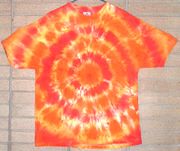
A T-shirt is a shirt, usually buttonless, collarless, and pocketless, with a round neck and mostly but not necessarily short sleeves.T-shirts have also become a medium for self-expression and advertising, with any imaginable combination of words, art and even photographs on display.T-shirts with prominent designer-name logos have been popular, especially with teenagers and young adults. These garments allowed consumers to flaunt their taste in designer brands in an inexpensive way.T-shirt exchange is an activity where people trade their tshirts they are wearing. Some designs specifically write on the shirt "trade with me"
In the early 1950s several companies based in Miami, Florida, started to decorate tee shirts with different resort names and various characters. The first company was Tropix Togs, under founder Sam Kantor, in Miami. They were the original licensee for Walt Disney characters that included Mickey Mouse and Davey Crockett. Later other companies expanded into the tee shirt printing business that included Sherry Manufacturing Company also based in Miami. Sherry started in 1948 by its owner and founder Quinton Sandler as a screen print scarf business and evolved into one of the largest screen printed resort and licensed apparel companies in the United States.
The most common form of commercial t-shirt decoration is screen-printing. In screen-printing, a design is separated into individual colors. Plastisol or water based inks are applied to the shirt through mesh screens which limits the areas where ink is deposited. In most commercial T-shirt printing, the specific colors in the design are used. To achieve a wider color spectrum with a limited number of colors, process printing (using only cyan, magenta, yellow and black ink) or simulated process (using only white, black, red, green, blue, and gold ink) is effective. Process printing is best suited for light colored shirts. Simulated process is best suited for dark colored shirts.
courtesy:wikipedia